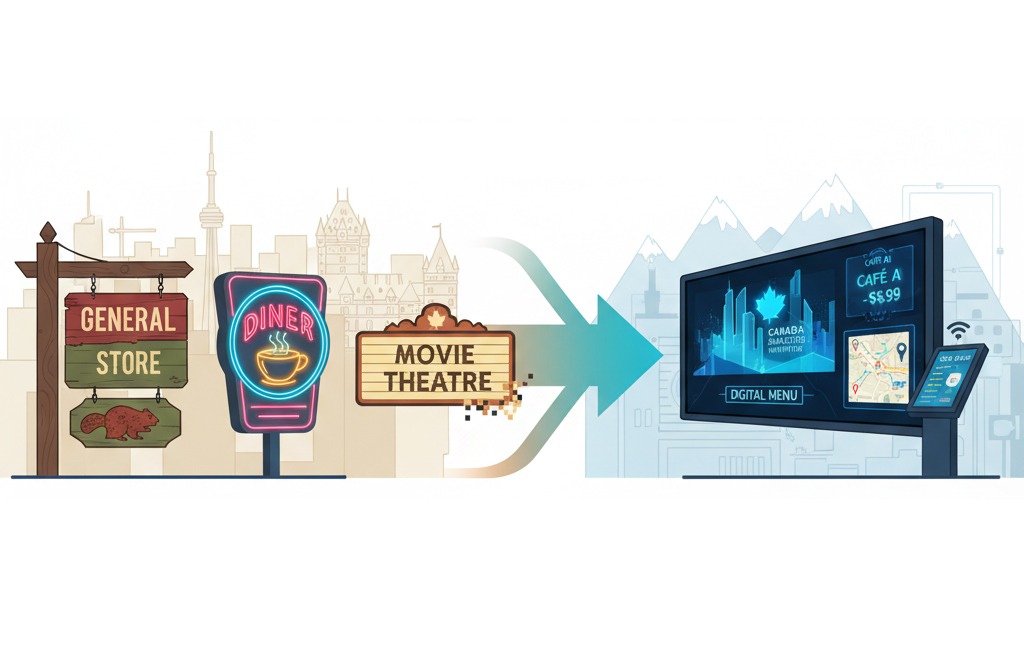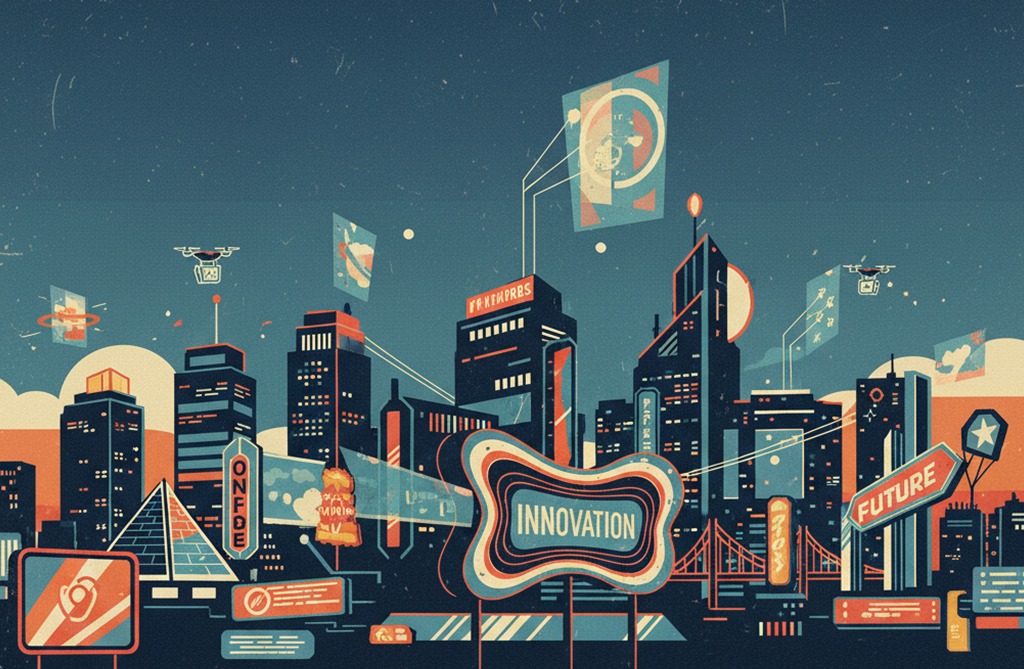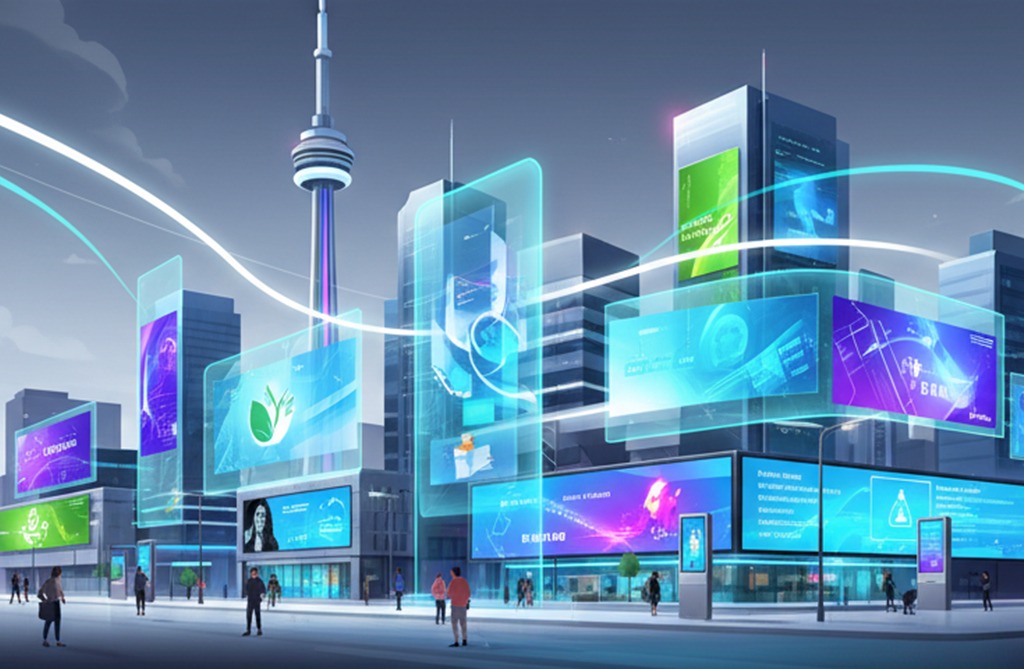Blog Post
The evolution of signage: From traditional to digital in Canada

In the heart of Edmonton and across Canada, the landscape of signage has undergone a remarkable transformation. The beautiful hand-painted wooden signage is an article of yesteryear in our modern world, when signs automatically light up or are part of a motion picture streaming through the sky, let alone their digital displays. Signage today is no longer simply a wayfinding instrument—it’s an impactful platform to tell your brand story and communicate with your customers. Entice customers instantly through the door by giving them more than simply basic directional information.
A glimpse into traditional signage
In days gone by, signs were made with artistic care. During the early days of business in Canada, especially in the city of Edmonton, signs were frequently made from wood, metal, or glass. Those old-school signs felt permanent and hand-crafted. Whether it was a swinging pub sign in Old Strathcona or a hand-lettered front window in downtown Edmonton, these were signs that told stories.
Sign companies in those days were artisans. They used brushes and chisels, stencils, and ingenuity to paint signs that were practical as well as beautiful. It was very time-consuming, and every sign was one of a kind. Materials such as wrought iron and gold leaf were typical in premium signage, particularly for banks, law firms, and government buildings.
We’ve built great cities and multiplied businesses, but we’ve really left it to an era of fast-moving tech companies to try and innovate around signage.
The emergence of industrial signage
In Canada, in the mid-20th century, there was a transition from hand-painted signage to low-cost mass-produced signs. Plastics, neon, and vinyl were among the materials that gained favor, enabling sign companies to make signs more quickly and cheaply. The growing commercial development in Edmonton, the heart of Alberta’s flourishing oil and gas industry, had a demand for bold, visible signage.
Banners and signs that lit up Jasper Avenue became a part of the landscape; vinyl banners were just about mandatory for any local event or special. Signage was now about more than appearances — it was about visibility, branding, and impact.
That is when we first started to see standard signage. Signage companies introduced a catalog model, where businesses had to choose from pre-designed options. While that decreased flexibility, it also opened signage to small businesses and startup customers.
The digital revolution
Jump to the 21st century, and signage has evolved to a new dimension—digital. In cities such as Edmonton, digital signage is a familiar sight from the LED billboards of the Anthony Henday to interactive building directories at West Edmonton Mall.
Digital signs offer unparalleled flexibility. Copy can be adjusted in real time; animated elements can grab attention and content driven by data can be focused on specific audience sets. A restaurant in downtown Edmonton can advertise lunch specials during its peak hours and offer a completely different dinner menu come evening with a few clicks.
Sign companies have rebranded themselves as tech-savvy firms, providing the equivalent of content management systems, remote updates, and analytics. Integration of AI and IoT has expanded the horizons of what digital signage can do for businesses in an effort to track engagement and message optimization.
Endlessly innovative signage in Edmonton

But Edmonton has enthusiastically jumped on the evolving signage bandwagon. The city’s broad economic base — including everything from shops and restaurants to schools and doctors’ offices — depends on clear signage to inform residents and visitors.
Edmonton local sign companies are pushing the boundaries. They marry old-world artistry with newfangled tech, providing hybrid solutions that mesh physical signs with digital overlays. For example, a boutique in Whyte Avenue could utilize a traditional wooden sign combined with digital window displays exhibiting the seasonal collections.
Additionally, the commitment by Edmonton to be a smart city is opening up possibilities for interactive signage in public areas. Touchscreen directories, real-time transit information and multilingual wayfinding signs are all becoming more prevalent.
Why signage still matters
But despite the digital transformation, the fundamental use of signage is still the same: to tell a story and keep viewers informed. Be it a roadside billboard or a glitzy LED panel, a sign is frequently the first encounter between business and audience.
Here’s why signs remain indispensable:
- Brand recognition: A good sign can be key to a business’s branding and selling point.
- Visibility: Signage allows businesses to communicate visually in crowded markets.
- Customer experience: Better wayfinding and less confusion with clear signage.
- Marketing: Sales-busting signs and promotional material that enhance your offers and collect store sales.
In a crowded business district like Edmonton, good signs can be the difference between being seen and not getting noticed.
The future of signage in Canada

As we look forward, signage in Canada is about to change even more. AHIDX Virtual content will be AR-enhanced, accessible using voice-activated displays and personalized. Picture strolling by a sign in Edmonton that says hello to you by name and provides customized recommendations based on your tastes.
Sustainability, too, is a growing area of interest. Environmentally friendly materials, energy-saving illumination options and recycling of components are great ideas from some progressive sign companies. Edmonton’s green efforts complement this change, and encourage businesses to use impactful signage that is good for the environment.
Choosing the perfect sign company
There are countless choices to choose from when selecting a company to make your sign. Whether you’re a new start-up in the ICE District of Edmonton or an old retailer in Sherwood Park, your signs should speak to how your brand sounds, looks, and lives. Here are a few tips:
- Evaluate your needs: When you think of signage for your company, do you imagine static signs, electronic digital ones, or a hybrid?
- Review portfolios: Seek out sign companies that have worked for clients in your industry.
- Think long term: Opt for materials and styles that will far outlast the current era.
- Local expertise: Sign companies in Edmonton know the local market and its regulations.
Ready to step up your signage?
If you are considering any upgrades to your signage, whether it’s traditional or digital or a combination, Postcard Portables Canada can offer guidance. One of the top sign companies in Edmonton and across Canada, we focus on creating custom signs that help your business get noticed!
From mini billboards to vibrant digital advertising, we use creativity and local knowledge to help businesses succeed. Whether you’re advertising a new product, promoting a grand opening, or just freshening up the storefront, we’ve got you covered. Become a part of Postcard Portables Canada today!
Blog Search
Recent Blogs
- How Customer Service Brings World Peace
- High five to postcard portables! 5-year cfa franchisees’ choice designation winner
- Hats off to our franchise of the year award winner!
- Wacky hockey facts a successful business should know
- Five Reasons Why Successful Businesses Stink
- BEST BUSINESS BOOKS TO HIDE FROM YOUR COMPETITION
- WHY BUILDING BUSINESS RELATIONSHIPS IS LIKE DATING
- FIVE BUSINESS NETWORKING TIPS YOU NEED TO SUCCEED
- BEST BUSINESS CARD DESIGNS TO SQUASH THE COMPETITION
- BILLBOARD DESIGN TO MAKE MONA LISA SMILE